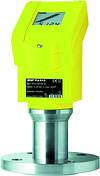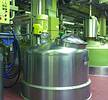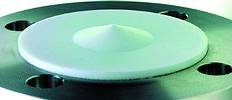
Sensors in the foodstuffs and pharmaceutical sectors must meet criteria such as long working life, accuracy, long-term stability, robustness, simple commissioning and resistance to chemicals. The Vegapuls 43 radar level sensor fulfils this requirement profile. It was specially developed for use in hygienic and sterile production and meets the GMP, GHP, EHEDG, FDA and 3A guidelines.
Regardless of all the differences in the manufacture and processing of foodstuffs, and the preparation of pharmaceutical products, there is fundamental unity with regard to hygiene and asepsis. Production processes must ensure that products are not contaminated, are biologically impeccable, and above all keep well.
In process measurement technology, radar level sensors are common, frequently-used devices, but not in pharmaceuticals and foodstuffs production. Here, radar sensors are to be found only in production sectors that are not hygienically relevant. The reason for this is the method used to guide the radar signal into the container in which the level is to be measured. In this zone, which is in fact the antenna, the high-frequency radar signal, at 26 GHz, leaves the sensor and is propagated in vacuum, air or gas at the speed of light. Radar pulses reflected form the sensor's surroundings and the material with which the vessel is filled are then received back at the antenna as radar echoes. The time that elapses between the electromagnetic waves being sent and received again is proportional to the distance they have travelled and so to the filling level.
Up to now, radar sensor antennas have been of horn or rod form. From the point of view of hygiene, however, these forms of antenna are unsatisfactory. Their acute angles and narrow gaps offer almost ideal conditions for dirt to collect, and CIP (cleaning) or even SIP (sterilisation) is not adequately possible, or extremely work-intensive and thus very expensive.
The Vegapuls S 43 hygienic radar level sensor provides an alternative. This radar sensor has an antenna, which, from the point of cleaning, is like the smooth walls of the container. The previous horn or rod antenna is no longer to be seen. Only a small conical nose projects into the process vessel. This small cone acts as a focusing lens for radar waves, with which it concentrates into a high-frequency beam. The relative dielectric constant of this small 140o ETFE cone substitutes for the refractive index of a lens.

The visible portion of the antenna, in the form of a small cone, imparts no impression of how precisely the geometric form of the antenna must be adapted to the physical properties of the electromagnetic waves. This cone focuses the electromagnetic waves, somewhat like a directional microphone, contributing to the sensitivity of the sensor. The manufacture of such electromagnetic lenses requires great empirical know-how in the field of high-frequency properties of materials.
Hygienic design
Besides the geometry necessary for easy and thorough cleaning mentioned above, the material used for the newly-developed sensor, Vegapuls 43 foodstuffs and pharmaceuticals antenna, is also decisive for cleaning and sterilisation. In practice, automatic cleaning (CIP) and sterilisation (SIP) of the entire production unit (and that means without changing it from its working status, let alone dismantling or stripping any part of it) is far from simple. Contaminants adhere mechanically in pores, gaps, scratches and recesses, and bond due to electrostatic forces to surfaces. The plant and sensor installations must therefore be designed so that neither the materials selected nor their surfaces favour the mechanical retention of contaminants or the formation of pockets of dirt. In these favourable circumstances, CIP cleaning is able to overcome the electrostatic and mechanical bonding energy of contaminants (yeast cells, moulds, bacteria). The emery for removal and separation of dirt is provided in chemical (cleaning agents), mechanical (pressure/flow speed), and thermal forms. In this process, the size of the relevant bacteria in relation to surface finish determines how great the mechanical bonding energy is. Gaps resulting from the plant design often spell defeat for reliable cleaning. In simplified form, the cleaning success, RE, can be expressed as a relationship made up of the components M (mechanical), Z (time), T (temperature) and C (chemical): RE = M x Z x T x C

Within certain limits, these factors are mutually replaceable. For example, a lower temperature can be compensated by a higher concentration of cleaner or higher flow speed. Optimum cost-effectiveness is, however, all too easily sacrificed. A well-meant increase in cleaner concentration by the plant operator, for example, from an optimum 2 to 2,3% can rapidly increase costs without improving the results of cleaning. The higher concentration changes the Reynolds number of the system, which results in reduced turbulence and speed of flow of the cleaner. The greater chemical cleaning effect is cancelled out by a reduction in mechanical cleaning and the overall success of cleaning can even deteriorate.

ETFE instead of PTFE
In the hygiene sector, PTFE is a material frequently employed. The small plastic cone, which serves as both antenna and process seal for the Vegapuls 43 radar sensor for sterile and pharmaceutical applications, is made of TFM-PTFE material (abbreviated to ETFE). This is a fluorine-based thermoplastic, which has significant advantages compared to PTFE, for example: lower deformation under load, a considerably denser polymer structure and a smoother surface (RA <0,8 (m). The well-known advantages of PTFE, such as high temperature resistance (>250°C), high resistance to chemicals and freedom from brittleness and ageing, are not just retained, but even improved. Perfluorinated elastomers and fluorinated thermoplastics are resistant to almost all chemical media, for example amines, ketones, esters, ethers, acids (sulphuric acid, phosphoric acid, hydrochloric acid and nitric acid), alkalis, fuels, oxidising agents and oils. Thus, apart from the chemical industry, the sterile and pharmaceutical sectors use these materials increasingly. The only limits to their application are posed by fluorine at high pressure and molten alkali metals like sodium and potassium, with which perfluorinated elastomers and fluorinated thermoplastics react explosively.

Particular hygiene through ETFE
The special material properties of the TMF-PTFE antenna/seal (ETFE) used on the hygienic radar sensor are achieved by chemical modification of the molecules and a special molecular structure. In a helical, linear ETFE-molecular structure that is similar to the molecular structure of DNA, the fluorine atoms screen the carbon atoms sterically (spatially homogeneously). This results in a very dense arrangement of the molecules. The energy of the C-F bond is exceptionally large, 485 kJ/mol compared to 413 kJ/mol for the C-H bond. In addition, the covalent radius of the fluorine atom is 0,72 Å (72 nm), much greater than the 0,37 Å of hydrogen atoms, which dominate in other hydrocarbon (C-H) compounds. This explains the exceptional thermal and resistance of ETFE.
The technical data of the Vegapuls 43 level sensor meet the demand profile for applications in pharmaceutical and foodstuffs technology. Limits to its application are posed only by products that form foam, and products with a highly mobile surface.
Some technical data on the Vegapuls 43:
Process temperature -40 to 150°C
Process pressure -100 kPa to 1,6 MPa (-1 to 16 bar)
Ambient temperature 40 to 80°C
Protection class IP 66 and IP 67
Ex-approvals Zones 0 and 1
Foodstuffs approvals 3 A, EHEDG
Loop-powered (4-20 mA, Profibus, FF)
Surface finish RA <0,8 (m)
Typical requirements for hygienic filling-level sensors:
* Pressure-resistant, even to high dynamic pressure pulses.
* Resistant to heat and cold (process temperatures up to 150°C).
* Process pressures up to 600 kPa (6 bar).
* Highly resistant to chemicals and universally usable process contact materials.
* High linearity, accuracy 0,1%.
* Long working life, robust and long-term stable.
* 4-20 mA loop-powered.
* Bus technology/digital communication.
* Ex-approved (EExd and EExia).
* Availability of common process connections.
* Easy to install.
* Rapid commissioning.
* Abrasion-resistant.
* Reliable CIP (cleaning in place), SIP (sterilisation in place) and FIP (flushing in place).
* Robust housing technology for which even permanent exposure to steam jets is no problem.
* Gap-free, flush-mounting.
Vega Instruments SA
(011) 958 1901
| Tel: | +27 11 795 3249 |
| Email: | [email protected] |
| www: | www.vega.com/en/home_za |
| Articles: | More information and articles about VEGA Controls SA |

© Technews Publishing (Pty) Ltd | All Rights Reserved